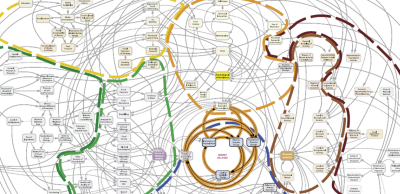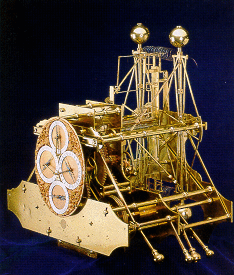 The theme this week has been emergent learning.
The theme this week has been emergent learning.
By that I mean the ‘ah ha’ moment that happens when lots of bits of a conceptual jigsaw go ‘click’ and fall into place.
When, what initially appears to be smoky confusion suddenly snaps into sharp clarity. Eureka! And now new learning can emerge.
This did not happen by accident. It was engineered.
The picture above is part of a bigger schematic map of a system – in this case a system related to the global health challenge of escalating obesity.
It is a complicated arrangement of boxes and arrows. There are dotted lines that outline parts of the system that have leaky boundaries like the borders on a political map.
But it is a static picture of the structure … it tells us almost nothing about the function, the system behaviour.
And our intuition tells us that, because it is a complicated structure, it will exhibit complex and difficult to understand behaviour. So, guided by our inner voice, we toss it into the pile labelled Wicked Problems and look for something easier to work on.
Our natural assumption that a complicated structure always leads to complex behavior is an invalid simplification, and one that we can disprove in a matter of moments.
Exhibit 1. A system can be complicated and yet still exhibit simple, stable and predictable behavior.
 The picture is of a clock designed and built by John Harrison (1693-1776). It is called H1 and it is a sea clock.
The picture is of a clock designed and built by John Harrison (1693-1776). It is called H1 and it is a sea clock.
Masters of sailing ships required very accurate clocks to calculate their longitude, the East-West coordinate on the Earth’s surface. And in the 18th Century this was a BIG problem. Too many ships were getting lost at sea.
Harrison’s sea clock is complicated. It has many moving parts, but it was the most stable and accurate clock of its time. And his later ones were smaller, more accurate and even more complicated.
Exhibit 2. A system can be simple yet still exhibit complex, unstable and unpredictable behavior.
 The image is of a pendulum made of only two rods joined by a hinge. The structure is simple yet the behavior is complex, and this can only be appreciated with a dynamic visualisation.
The image is of a pendulum made of only two rods joined by a hinge. The structure is simple yet the behavior is complex, and this can only be appreciated with a dynamic visualisation.
The behaviour is clearly not random. It has an emergent structure. It is called chaotic.
So, with these two real examples we have disproved our assumption that a complicated structure always leads to complex behaviour; and we have also disproved its inverse … that complex behavior always comes from a complicated structure.
The cognitive trap we have exposed here is over-generalisation, the unconscious habit of slipping in the implied [always].
This deeper understanding gives us hope.
John Harrison was a rare, naturally-gifted, mechanical genius. And to make it easier, he was working on a purely mechanical system comprised of non-living parts that only obeyed the Laws of Newtonian physics. And even with those advantages it took him decades to learn how to design and to build his sea clocks. He was the first to do so and he was self-educated so his learning was emergent.
If there were a way to design complicated systems to exhibit stable and predictable behaviour, how could more of us learn how to do that?
Our healthcare system is not made of passive, mechanical cogs and springs. The parts are active, living people whose actions are limited by physical Laws but whose decisions are steered by other policies … learned ones … and ones that can change. These learned rules of thumb are called heuristics and they vary from person-to-person and from minute-to-minute. Heuristics can be learned, unlearned, updated, and evolved.
This is called emergent learning.
And to generate it we only need to create the context for it … the rest happens … as if by magic … but only if we design a fit-for-purpose context.
This week I personally observed over a dozen healthcare staff simultaneously re-invent a complicated process scheduling technique, at the same time as using it to eliminate the queues, waiting and chaos in the system they wanted to improve.
Their queues just evaporated … without requiring any extra capacity or money. Eureka!
We did not show them how to do it so they could not have just copied what we did.
We designed and built the context for their learning to emerge … and it did. On its own.
The One Day Practical Skills Workshop delivered emergent learning … just as it was designed to do.
A health care system is a complex adaptive system (CAS), and system improvement-by-design is what systems engineers (SE) are trained to do.
And this emerging style of complex adaptive systems engineering (CASE) is at the cutting edge of human knowledge, and when applied in the health care domain it is called health care systems engineering (HCSE).
Our experience of the emergent learning that flows from the practical skills workshops verifies that CASE is both possible, learnable, teachable, applicable and effective.
